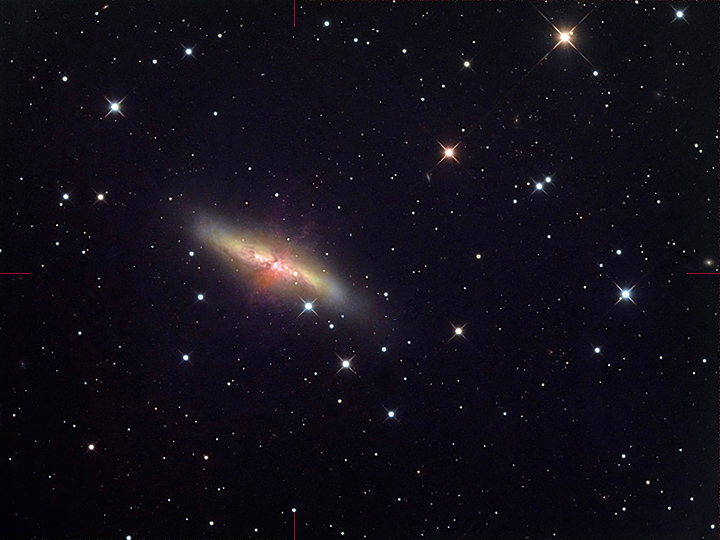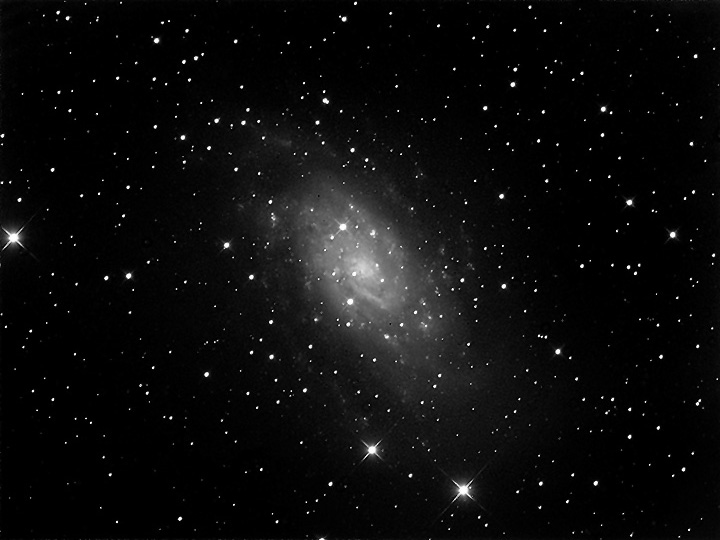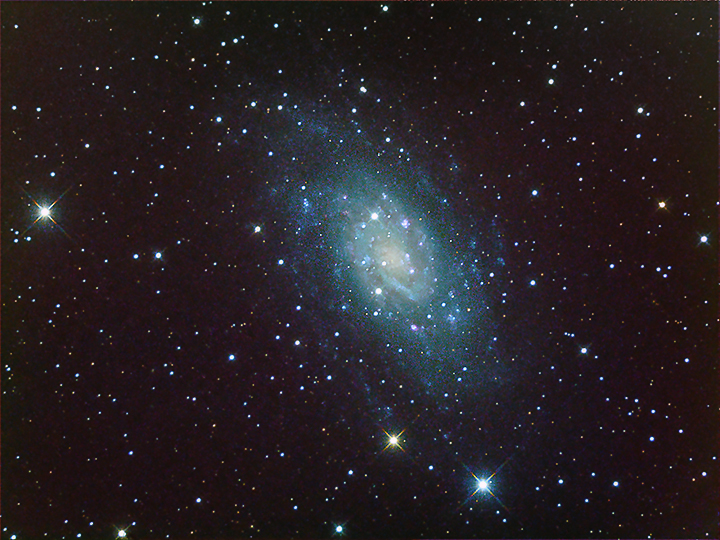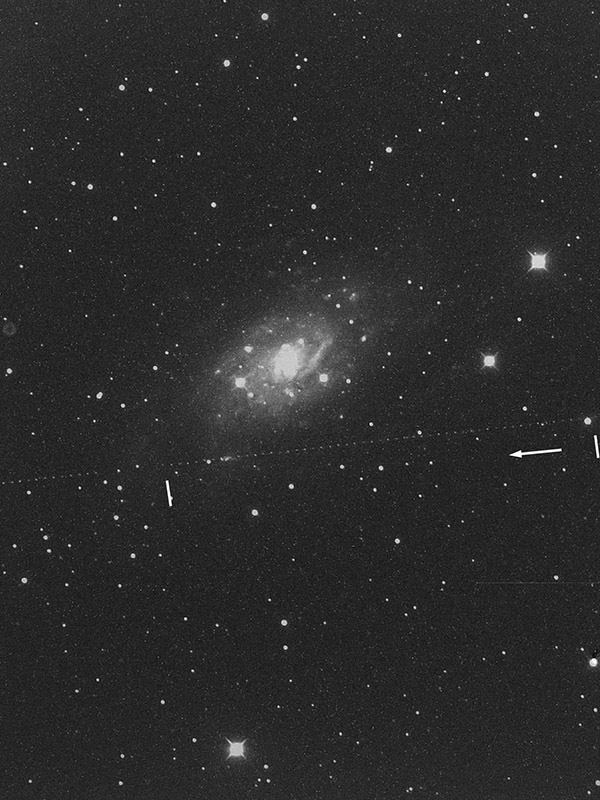2/28/2014. I know it's "the slowblog" but surely I can do better than once a month. I opened up the CCD to remove some dust that had been serving as condensation and frost nuclei and to see if the big O-ring under the faceplate was well seated. Maybe I'd mashed the O-ring on one side; maybe something about it wasn't perfect. I did not find any obvious flaws. I put everything back together, changed the desiccant pack again, taped the seals this time, and set everything up for a very clear night. I'd blown off the last two clear nights and thought that I'd lose any right to complain if I didn't make use of this one. Here's M82 and its past-its-sell-by-date supernova:

SN 2014J in M82
32x300s L (3 hrs)
12x300s RGB (3 hrs total)
Using the L-frames for photometry, I get about 11.3 for the supernova, well off its peak brightness. Tracking was exceptionally tight, focus was decent, seeing was good. I think it was a night well spent. I didn't want to mess up the galaxy with the usual pointers to the supernova, so find them along the edges of the frame. First thing this morning, I realized that yesterday's cleaning fit meant that I desperately needed to shoot a flat frame (you need one for every night's take --one for every camera orientation is nice, too-- although sometimes you can reuse a recent flat without much harm; but after moving the dust around on the chip I really needed a fresh flat). I put the diffuser on the telescope and threw a towel over that to knock down the morning twilight. I took 16 half-second exposures which I averaged into today's flat. I like having enough color data (for once) that I didn't have to stretch the color channels until they broke down into noise and nasty gradients.
3/4/2014. At Staples, I bought a pack of nylon brushes and a can of DustOff and then had a high old time cleaning dust and assorted crap off the CCD (and from every piece of glass between the telecompressor and the detector). I "bathed" the brush in the high speed stream for a few seconds to static-charge the brush then used it to sweep the surface of the CCD. When that didn't work perfectly, I used the A-P cleaning kit (Baader Optical Wonder and lint-free tissues, cautiously) to help the dust along, then repeated the static-charge thing to get rid of new dust, lint, and so on until visible dust is not. I finished with a good blast of air. I changed the desiccant yet again, this time making sure that the Particle Wave Technology holder was firmly seated (I found that it wiggled a little and could be easily turned by hand so its O-ring may not have been tightly seated; fixed). I retaped the junction between the CCD faceplate and the rest of the camera using vinyl "electrical" tape. When last examined, the chip looked good using a magnifying hood and direct sunlight -- before cleaning, I could see the ice-forming nuclei clinging to the glass and insured that they were removed. The weather will make it easy to wait at least 24 hours, and then we'll see how clean and frost-resistant the CCD is. These brushes seem a little coarse; stay alert for some better suited to this purpose.
I really should make some photos the next time I have it apart -- there's a lot of lovely engineering in there -- but I'm always anxious to seal the case again before dust invades and the camera's circuit boards absorb too much moisture.
3/5/2014. NGC 2403, a biggish galaxy in Camelopardalis, became my test subject. It cleared Bird Feeder Pine at the end of twilight and should be visible most of the night. I set up an 8 hour sequence of 300s exposures. Robofocus kicked up some (its window disappeared, fixed by deleting the appropriate section of robofocus.ini and relaunching it; the hand control was hot in the inward direction [solution below!] and messed up the focus position, I unplugged it and manually reset the focusser: got lucky, nailed it on the first try, so close that I declined to invite more calamity by fine-tuning). The camera looks good. The chip is very clean, but I still saw frost just below -20°C. It's newly resealed, so give it a few days and we'll see if the frost issue is fixed, too. Note for another day: dream up something less claptrappy than ad hoc rubber bands to assist the focuser when lifting the CCD/CFW. And bake the desiccant that lives in the camera's storage box; it's too saturated to help anything right now.
And next time, make damn sure the telescope is on the proper side of the pier before turning it loose all night <sigh>. This isn't even a decent start:

NGC 2403
15x300s L (45m total)
3/7/2014. The Robofocus hand control is fixed. It's untested, but I'm 99% sure the problem is solved. This is a rare occasion: I opened up a piece of electronics "to see if I could see a problem," and I did! The "in" button was shorted. The soldered leads of the two push buttons are not insulated, and if you rotate a button too far (as when tightening its retaining ring against the faceplate), the leads can touch, effectively pressing the button. That's what I found. I derotated the "in" button and wrapped one lead in insulating tape. Next clear spell, we'll see if it's really fixed.
Ha! I got good skies sooner than expected, and yes, it's fixed.
Running the camera into the pier and having the motor report "stalled" for several hours last niht loosened the RA motor. I remeshed it this evening, aimed at the Moon and recalibrated, but don't know whether PEC has suffered. I nailed the focus on Capella, saw frost-free images at -23.6°C when the camera overshot its -20°C set point, and am determined to get NGC 2403 tonight. Note that when using the Bahtinov mask to focus, movements of just +/- 5 Robofocus steps make a discernable difference. I shot flats as twilight deepened. I began taking images as soon as NGC 2403 moved into open sky and continued as it set into the trees in the NW. Here's the pile of all available frames:

NGC 2403
68x300s L (4h 40m), 6x300s RGB (30m per channel)
6h 10m total
I saw sub-arcsecond maximum excursions all night long and RMS tracking in the 0.2 arc second range in both axes. Transparency diminished late, and the best images came during a two hour window opening a little before midnight. There's always a question: which produces the better image, more data of (merely) decent quality or a smaller pile of only the best? For your consideration: compare the image above which was made using all available data with the one below made from only the best 19 luminance frames (FWHM less than 2.6 arc seconds and contrast greater than 20%). Both used all available colord data.

NGC 2403, data filet
19x300s L (1h 35m), 6x300s RGB (30m per channel)
3h 05m total
Anybody up for a spacefaring mystery? What was this satellite or piece of (presumably very distant) debris? Something entered the frame traveling west to east during the 300s exposure beginning at 5:06:42 UT on March 8, 2014.. It flashed 50 times before the end of the exposure. No sign of the satellite appears in the previous exposure, but it continues in the next frame (beginning at 5:11:58 after a gap of 16 seconds while the camera read the CCD, downloaded the data, and began the next exposure). The timestamps are accurate to within a few seconds according to the US Naval Observatory's time server. Click the image below for a full-resolution sum of the two frames showing the satellite's path. The tick marks indicate the visible track in the first frame. To the left is the track as it exited the second frame. The image scale is 1.29 arc seconds per pixel (the image is 25.8 minutes of arc from side to side), north is at top, east at left, the center is near 7h36m42s, +61°31'20". The photo was made from 35°46.29'N, 81°30.35'W.

Except where noted, deep-sky photos are made with an SBIG ST2000XM CCD behind a 10-inch Astro-Tech Ritchey-Chretien carried on an Astro-Physics Mach1GTO. The CCD is equipped with Baader LRGB and 7nm H-a filters. The internal guide chip of the CCD most often keeps the OTA pointed in the right direction (I'll let you know when a Meade DSI and a separate OAG or guidescope takes its place). Camera control and guiding are handled by Maxim DL 5.12. The stock focuser on the AT10RC has been augmented with Robofocus 3.0.9 using adapters turned on the lathe downstairs. Maxim performs image calibration, alignment, and stacking; Photoshop CS4 and FocusMagic 3.0.2 take it from there. Gradient Xterminator by Russell Croman and Astronomy Tools by Noel Carboni see their share of work, too. Beginning in May 2013, PixInsight has taken over some of the heavy lifting for transfer function modification and deconvolution.
:: top ::